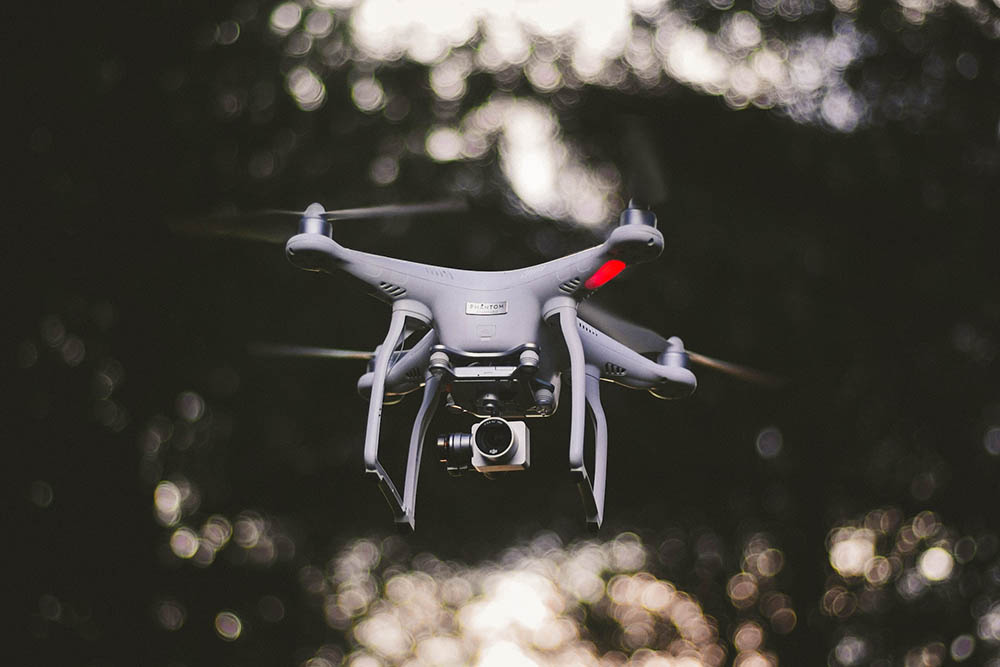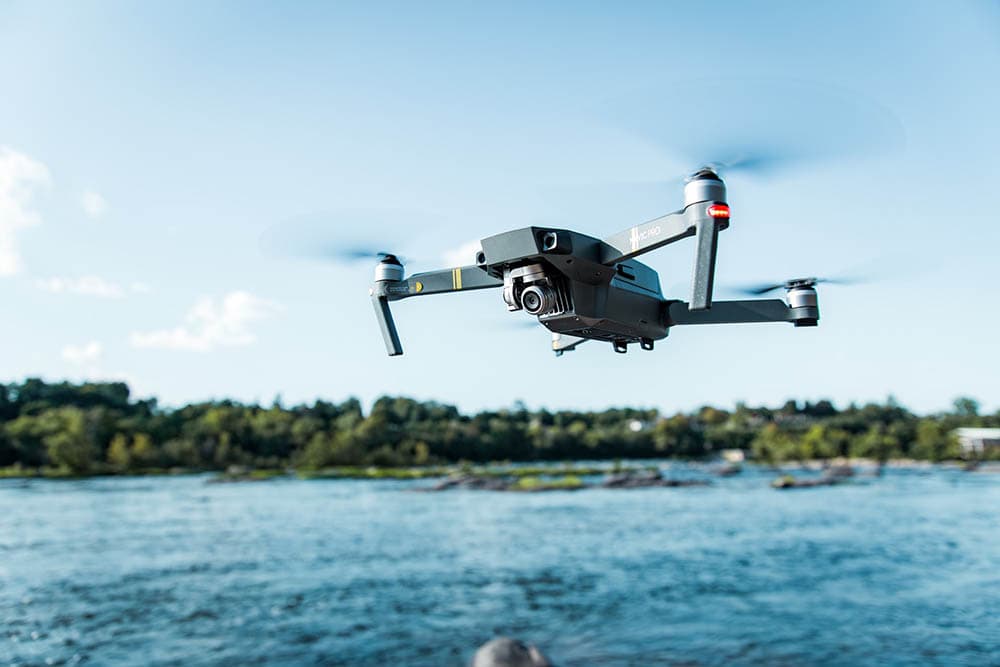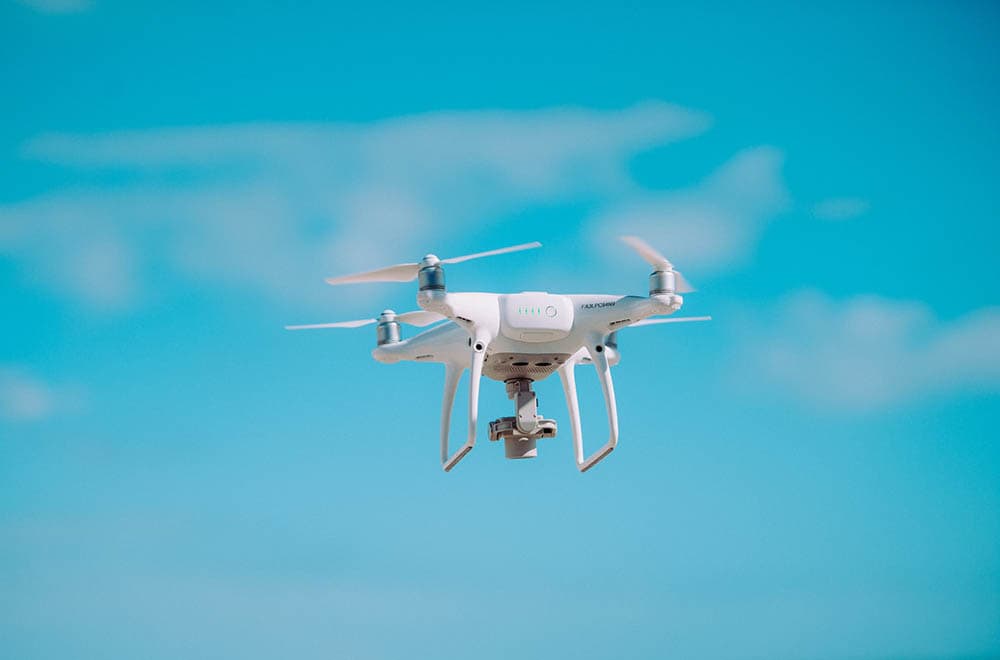What Are Drones? How Do Drones Work? Everything You Need to Know
Last Updated on

Most of us are familiar with drones these days, and some of us even own one. They come in handy for creating incredible aerial shots for videos and can provide laughs when the cat swats them down. The drones designed for commercial use tend to be easy to fly and maneuver, and some are quite affordable.
They work via a combination of physics and wireless capabilities. Let’s go over more of the mechanics of how drones fly.

How Do They Work?
Drones have various mechanics that make them work.
Rotors
Most drones have four rotors, which are propellors attached to motors that enable them to move up, down, side to side, rotate, and hover.
The rotors push the air down, which helps lift the body into the air. In order to hover, two of the spinning blades spin counterclockwise, and the other two spin clockwise.
The faster the propellors spin, the faster and higher the drone can go. All actions that the drone participates in depend on the speed of each of the propellors.
Wireless Connection and Control
Drones are typically controlled through a wireless connection and GPS, usually through a tablet or your smartphone, enabling you to see from the drone’s perspective.
While they are on the ground, they use remote ground control systems. Many also have obstacle-avoidance sensors.
Many drones can be pre-programmed to specific coordinates and can provide you with the battery status while in flight. In order to keep them light, drones typically only use small batteries, so keeping track of the battery is important!
Accelerometer and Altimeter
Drones also use the accelerometer, which provides information about the direction and speed of the drone, and the altimeter, which gives information about the altitude. These help the drone land slowly and safely.

What Are the Different Types of Drones?
There are only two different kinds of drones. We are most familiar with rotary drones, and the other ones are fixed-wing drones.
A rotor drone can be single rotor or multi-rotor, which includes three, four, six, or eight propellors, with the four propellors, or the quadcopter, being the most popular.
A fixed-wing drone has two wings fixed to the body. The wings are used to help in lifting the drone, but even with wings, they can take off and land vertically and don’t need a runway.
Where Are They Used?
Where drones are used depends on whether they are meant for personal or commercial use. Beyond filmmaking, racing, or other entertainment venues, drones have been used for:
- Delivery: This is fast becoming a popular way for restaurants and grocery stores to deliver goods to customers.
- Filmmaking:Taking photographs and creating aerial shots in films is an affordable method when using a drone. This way, using aircraft or helicopters is not necessary.
- Surveillance:This is an affordable method for various aerial surveillance situations, including tracking forest fires and monitoring livestock.
- Military:Drones are well-known for their work in the military, which includes airstrikes and bomb detection. They are often equipped with advanced tools, such as thermal imaging and laser range finders.
- Disasters:Delivery of medical supplies and search-and-rescue are just a few ways that drones can help in disaster relief.
- Information:Different industries use drones for information gathering. The agricultural sector can help optimize agricultural production with drones by measuring and recording the height of the crops. They are also used for things such as taking water- and air-quality readings.

Advantages of Drones
Drones have many advantages:
- Cost: They are more cost-effective for some industries. Filmmakers can use drones for aerial shots rather than paying for a helicopter and pilot.
- High-Quality Images: You can get high-quality photographs and videos with the right drone. This also includes using these images for 3D models and maps to enable rescue teams to better prepare for hazardous conditions.
- Easy to Use:It can take a bit of practice to get the hang of them, but learning the controls is easy enough for beginners.
- Maneuverability:They can be maneuvered into precise locations. They can fly in more directions and lower than any crewed aircraft or in difficult-to-access areas (whether it’s a tight space or dangerous to access).
- Safety and Security:Drones can be used for security purposes, such as surveillance during public gatherings and sporting events. They can also be put to use during natural disasters for recovery efforts.
Disadvantages of Drones
With the good comes the bad. The disadvantages of drones include:
- Privacy: This is probably the biggest concern about drones. Anyone can purchase a drone and take pictures of people, sometimes without them being aware of it. There have been cases of drone operators taking footage of people without their knowledge.
- Safety Issues:There have been cases of drones being used near airports or crashing into crowds of people, causing injuries.
- Legislation and regulations unclear: The rules and regulations for drones are uncertain. Laws are still under development, and drone operators might break rules that they weren’t aware of.
- Malfunctioning:Some drones might malfunction and cause injury.
- Hacking:While drones continue to improve and become more technologically advanced, this also makes them more susceptible to hacking. Hackers then have access to the information contained in the drone and can take it over.
- Skillset:While drones can be easy to use with time, certain aspects of operating a drone require advanced skills. If a farmer needs to use a drone for agricultural purposes, they might not have the necessary skills, and it can cost them more money to hire someone to do it for them.
- Slow data transfer:In the agricultural sector, it can take up to a week to download the results that are needed.
- Weather and animals:Drones are vulnerable to bad weather and animal attacks. There are cases of eagles attacking drones, but there’s also the risk of drones hurting wildlife.

Frequently Asked Questions (FAQ)
How long does it take to learn to fly a drone?
It takes about 2 weeks to learn how to fly a drone. You could master it faster if you’re already experienced in flying model aircraft. Be sure to practice in open fields, and always keep it at a safe height and location where you can see it.
Do I need a license to be a drone operator?
You’ll need to check with your county’s rules on this. Some counties expect everyone to have a license, while others might only require a permit if your drone is over a certain weight.
What is the average flight time of a drone?
This depends on your drone, and the instructions will give you information about this. But generally, for a beginner drone, the flight time might be 5 to 10 minutes, for a mid-range drone, about 10 to 30 minutes, and for an advanced drone, maybe 30 to 40 minutes.
Can I fly a drone when it’s raining?
Most drones are not weatherproof, so it’s best to bring them inside when the weather turns.
•You might also like: How Is Satellite Imagery Used in Agriculture? What to Know!

Conclusion
Drones are becoming increasingly sought after, and the technology will only become more advanced over time. They are used in industries for helping others but can also be used for fun — as long as they don’t infringe on the privacy and safety of others.
Remember to check with your region’s laws about the rules for being a drone operator. If you use them safely, drones are rife with possible applications.
Related Read: How Much Weight Can a Drone Carry? The Fascinating Answer!
Featured Image Credit: Allef Vinicius, Unsplash
About the Author Kathryn Copeland
Kathryn was a librarian in a previous lifetime and is currently a writer about all things birds. When she was a child, thanks to her love of animals she hoped to work in zoos or with wildlife in some way. She's not strong in the sciences, unfortunately, so she uses her time to research and write about all kinds of birds and animals, and hopes to bring that detailed knowledge to OpticsMag.
Related Articles:
Can You Use Binoculars to Look At Stars? How to Choose the Right Pair
How to Clean a Refractor Telescope: Step-by-Step Guide
How to Clean a Telescope Eyepiece: Step-by-Step Guide
How to Clean a Rifle Scope: 8 Expert Tips
Monocular vs Telescope: Differences Explained (With Pictures)
What Is a Monocular Used For? 8 Common Functions
How to Clean a Telescope Mirror: 8 Expert Tips
Brightfield vs Phase Contrast Microscopy: The Differences Explained
